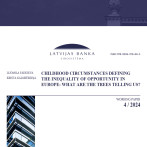Fluctuation in retail trade continues but future outlook still good
According to the Central Statistics Bureau, the retail turnover in June, seasonally adjusted data at constant prices, dropped 0.8%. The annual growth rate, however, remained relatively high at 4.6%. Thus in the second quarter of 2013, retail turnover remained unchanged (quarter-on-quarter, seasonal factors excluded), but grew 6.0% year-on-year, which means that in all likelihood, trade will represent one of the greatest positive contributions to the gross domestic product (GDP) growth in the second quarter.
In June, the previously observed trends still obtained: year-on-year growth is positive in the segments of household goods (+35.2%), as well as automobiles and motorcycles (+24.6%). Growth has been substantial also in the fuel trade volumes (+8.5%), whereas the growth rate is still sluggish in foodstuffs trade (2.7%).
The confidence indicators on June aggregated by the European Commission pointed to a dual situation: consumer confidence remained relatively high while retail trade confidence dropped substantially compared to the high levels at the beginning of the year. Business outlook regarding both the evaluation of the previous three months and the predicted results of the next three months deteriorated. The improvement in consumer confidence is primarily related to the improvement in the labour market: unemployment is gradually dropping and the average nominal salary is rising. Inflation likewise remains low, which has a positive impact on the purchasing power of the increase in nominal salary. This is confirmed by the improvement in the balance of replies of households to the question regarding predictions of their financial situation in the next twelve months.
Judging by the operational tourism branch indicators, a part of growth in the retail turnover could be explained by the increase in tourism activities. Even though growth in tourism is of seasonal nature, indicators point to a substantially greater number of tourists than in previous seasons. This is evidenced by the substantially increased occupancy rates of beds and rooms in hotels.
It is expected that in the coming months there will be no substantial changes in the retail dynamics – it will continue developing in a pendulum motion, with an upward trend. As the situation in the labour market is improving gradually, the activity of households is increasing, which is reflected also in the trade data.
As early as the first quarter of this year, GDP growth was primarily accounted for by private consumption. That means that for the time being, as the European economy is undergoing reorganization, Latvian economic growth has tipped more toward private consumption, which is a short-term solution. To achieve long-term balanced growth, the Latvian economy will need a rise in investment, which would then promote export growth. This is why the latest news from Europe sounds particularly good: conjunctural indicators are improving gradually and not only in Central Europe but also in the periphery. That may be the first signal that European economy may be poised for gradual recovery.
Textual error
«… …»






